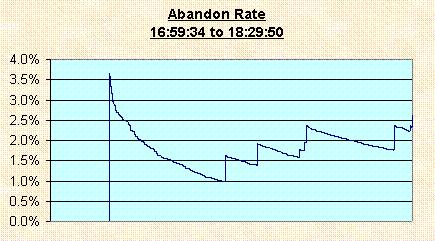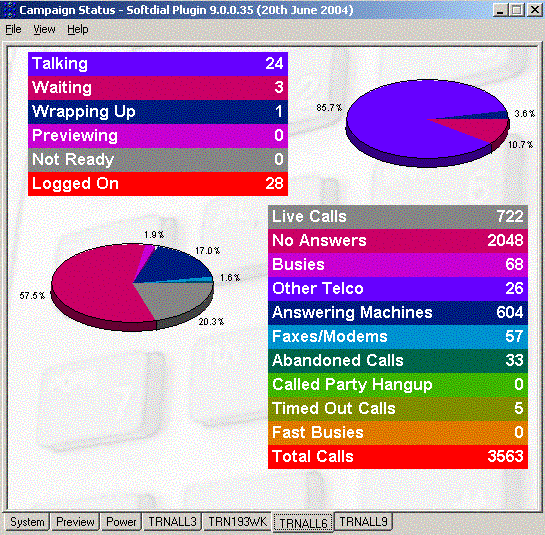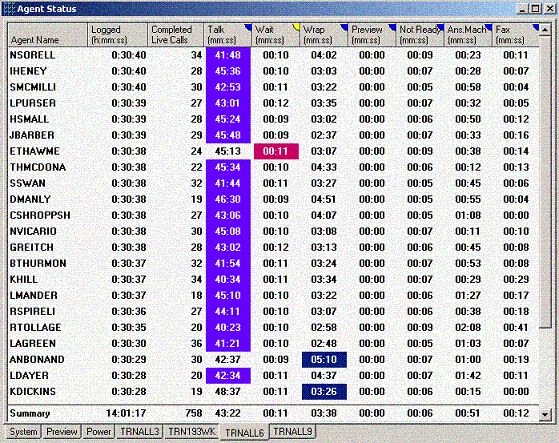 Predictive dialing offers the greatest return on investment from automated dialing systems. The underlying technology is complex and is almost always described only superficially by most vendors. Because of the high levels of automated dialing, what really takes place is not easy to determine. This may be the reason that while every dialer vendor claims to have the best predictive dialer, independent and objective evaluations are not available.
Predictive dialing offers the greatest return on investment from automated dialing systems. The underlying technology is complex and is almost always described only superficially by most vendors. Because of the high levels of automated dialing, what really takes place is not easy to determine. This may be the reason that while every dialer vendor claims to have the best predictive dialer, independent and objective evaluations are not available.
With predictive dialing, we are able to achieve very high rates of operator productivity by reducing the time between each collection call. The dialer has traditionally been able to do this by setting up a group of collectors in a “pool” and then placing more calls than there are agents, knowing that there will be a percentage of calls such as the busy’s and no answers that do not have to be transferred to an agent. These unconnected calls are documented in the system, and management is able to act on the results just as they would had the agent placed the call themselves. But because the entire process is automated, there is no effort expending in dialing the phone and no time is wasted on managing or documenting the unconnected calls. With the appropriate “pacing” technology, the dialer is able to predict the availability of agents and deliver connected calls with as little idle time as possible between each call.
The following benefits are realized with well-managed predictive dialing operations :
- As a result of significantly greater talk-times and less idle time, you will enjoy lower costs compared to calls made in any other dialing environment.
- The number of live contacts far exceeds the numbers in other dialing environments.
- Every user’s time is better managed as dialing errors are virtually eliminated.
- Even answering machines and operator intercepts can be identified, with management-defined action being taken to make the agent as productive as possible.
- Calling rules are handled by the system, thereby reducing your costs and preventing errors. This refers to long-distance coding requirements as well as time-zone management, to ensure that accounts are called at the right time in the day.
There are some disadvantages of using a predictive dialer in a collection environment. These are the following :
- It is difficult to give up the collection model that involves the ownership of accounts (usually in a collection agency setting). Typically, you need a “pooled” environment to effectively use a predictive dialing solution. With I-Tel, you can obtain the benefits of predictive dialing with as few as 4 agents in a campaign. With fewer agents, idle time will be high compared to having a larger number of agents. With predictive dialing in a “pooled” environment you must be prepared to sacrifice the ownership concept in return for potentially enormous gains in productivity.
- In an “ownership” or “cradle-to-grave” environment, giving credit to a collector for payments generated is a very simple task. In a predictive environment, where the accounts are pooled and several collectors may work the account at different times, measuring individual productivity is very complex. Most dialers will produce reporting that will indicate the number of calls connected, the results of those calls etc. But who is really collecting the money? RMExhas features that will allow you to measure individual productivity based on payments generated in a pooled dialer environment, thereby overcoming the major disadvantage of predictive dialing in the collection industry.
When predictive dialing is applicable, you usually work with different campaigns that are set up to target specific groups or types of accounts. With I-Tel, it is also possible to set up “agentless” campaigns which may be started outside normal office hours or for special types of accounts. Messages can be played when calls are answered or answering machines are detected.
ABANDONED CALLS
Any time you dial more than one call per agent, there is always the chance that you will get more than just one live call per available agent. Since an agent can only handle one live call at a time, it means that any other live call(s) cannot be dealt with immediately by an agent. Different dialers use various strategies to minimize and draw attention away from such calls. Recent legislation has highlighted the area of abandoned or nuisance calls, and more people are aware of the issues. However, for the average user, there are still more questions than answers. A well-designed dialer will launch calls such that the expected number of answered calls equates to the number of agents available, given that some numbers can be expected to be busies, no answers etc. But statistically, any time you dial out on more trunks than there are agents, you run the risk of nuisance calls. If you increase the dialing rate, then the incidence of such calls is certain to go up.
Each dialer company will promote its own proprietary method of balancing the abandoned call rate and idle time for an agent. It is very important to understand that the abandoned call rate is the ratio of abandoned calls to calls answered and not calls attempted. It is measured by dialer campaign. In general, the more calls you are willing to “abandon” the more “talk time” you can have for your agents.
What is the definition of an “abandoned call”?
An abandoned call is :
- a call that the dialer disconnects when a person answers, because no agent is available, or
- a call that is connected but the person receiving the call hears nothing because no agent is available for some defined period of time. Based on present legislation in the US (primarily targeted at telemarketing companies), that is about 2 seconds after the phone is answered. If an agent does not get to the call within that period, the call is deemed to be abandoned. You must play a short message and abandon the call (hang up). It may be permissible to hang up without playing a message but is it very important to understand that after the 2 seconds, the call must be counted as an abandoned call, regardless of how it is handled.
- In addition to the above, there is a class of “nuisance call” that has historically been made in the collection industry – This is a call that is canceled without waiting for the phone to ring a sufficient number of times (i.e. a minimum ring time of 15 seconds). This type of call is now banned in the US under both DMA rules as well as federal legislation, and we feel that it is likely to be disallowed in the collection industry too.
While all dialing products have a predictive dialing module, the most compelling differences between those systems and I-Tel may be the manner in which abandoned calls are managed. Our dialer engine was designed to meet the most stringent codes of dialing practices. It was designed specifically for a compliant world. With reference to this we have:

- A maximum abandoned rate of 5%
- There are no predictive hang-ups, i.e. there will always be a minimum ring time of 15 seconds
- The abandoned call delay maximum is 2 seconds
- To help you understand how the area of predictive dialer legislation has developed, the following provides additional reading.
- As far back as in 2002, the state of California was holding hearings on predictive dialer errors and setting up guidelines for responsible dialing. That resulted in Rule 02-02-020 as governed by the California Public Utilities Commission (CPUC). Changes were made to the Interim Opinion, but the early hearings give us good insight into what could happen when there is more consumer pressure to legislate the use of dialers. The rulings state that the maximum abandoned call rate allowed for predictive dialing telephone equipment (this was later changed to target telemarketing companies) will be 3% of answered (live) calls per campaign per month. The maximum call delay (the amount of time you have to get an agent on the call), before the call is deemed abandoned, should be within 2 seconds of the completed greeting, i.e. ‘Hello…’ Yes, there will be a penalty for non-compliance.
- Our dialer has always been able to meet the strict California compliance guidelines – some brief information can be obtained here.
- To review the area of “abandoned calls” in greater detail, please review the case study on “The elimination of silent calls caused by Predictive Dialers“.
PREDICTIVE DIALERS AND “PACING” METHODS
The productivity of a predictive dialer can be measured by the “predictive benefit” of the extra agent talk time it provides compared with simpler dialing methods such as progressive dialing. The quality of a predictive dialer lies in its ability not just to generate productivity but to do so whilst working under compliant dialing conditions. In a given period of time (and for a specific campaign), more contacts will be made when more accounts are dialed and the wait time between connected calls is kept to a minimum. Abandoned calls and wait times are simultaneously and successfully managed based on how a dialer “paces” itself. In the traditional model a dialer will dial more calls than there are agents, using different methods to determine exactly how many calls should be launched at any given time. If a dialer over-dials, you will be forced to abandon calls because there will be agents available to take the calls. If the system dials too slowly, wait times are increased and you will be making fewer contacts. Pacing is the heart and soul of dialer technology. The design and algorithms are technically very complex and the results will usually separate the effective dialer from all other dialers.
Most dialers have been caught short by the new Federal requirements on dialing. Whist in most cases it has been, as expected, relatively easy for them to achieve compliance with the new standards, achieving effective performance under compliance is something quite different, and a challenge that is proving too great for most dialer vendors. Most dialer designs originated in a market where there no rules and consumers were more tolerant of abandoned and other kinds of silent calls. For example, it was/is not unusual for a dialer to have a guess at the optimum dialing rate using some mathematical formula, and then go back and forth, under and overcorrecting as it seeks to find the right balance. Such “seeking” methods waste abandoned calls in a world where abandoned calls are suddenly becoming a scarce as opposed to a “free” resource. Federal agencies are clamping down on abandoned calls and collection agencies may eventually come within this net. So, can dialers cope under compliance? Read this interesting document that reviews the background of compliance and presents several little-known facts about this subject.
How does our dialer manage its pacing? We create a “dialing pool” – You could think of this as the area that we use to launch our predictive calls. When agents become free (not before), we put more numbers into the dialing pool. The more agents there are, the more the numbers we add as each agent joins. This is in recognition of the fact that as agent numbers go up, there is a stronger likelihood that another agent or other agents will become free to take any overflow calls. Within the system and taking account of all campaign events such as call outcomes and talk/wrap distributions, a very sophisticated simulator uses immense power to calculate the probability of an agent becoming available in the next second, 2 seconds, 3 seconds and so on. We dial not just for an agent, but for the way in which all agents are expected to become available. For a given abandoned call target, our dialer ensures that you get the best possible talk time per agent hour, or if you like, the lowest agent wait time achievable between calls.
Our design approach is very different from traditional dialer designs. The results are similarly different.
The following is an example of a “Campaign status inquiry” for predictive dialing. Answering machine detection was turned on. Note the small number of abandoned calls compared to the number of live calls (less than 5%).

The following is the agent status display for a predictive campaign. The color coding indicates the mode that the specific agent is in (Talk, Wait or Wrap). For the campaign, talk time per hour is about 43 minutes. Average wait time is 11 seconds and as the previous chart showed, the abandoned call rate is less than 5% (33 abandoned compared to 722 completed calls).

In the above, the yellow marker shows the average length of an event. E.g. an agent spending an average of 11 seconds in wait mode.
The blue markers show the amount of time spent in a particular state per hour :
- Logged – The amount of time spent logged onto the dialer during a shift.
- Completed live calls – The number of calls that the agent has been engaged in with a live contact during the shift.
- Talk – The time the agent spends talking to a live contact.
- Wait – The time spent once both talk and wrap have been completed, before the agent receives another call.
- Wrap – Time spent updating screen details once the talk phase has finished and prior to going into wait again.
- Preview – Any time spent previewing screen information before asking the dialer to place a call.
- Not ready – Time when the agent is logged into a campaign but unavailable for calling purposes as they are on a break.
- Answer machine/Fax – Any time spent by the agent detecting and terminating any such calls that might be put through to them, if machine detection has not been enabled. This may require some coding on the dialer side and may not be applicable in RMEx
 Sytel has been supplying world-class predictive dialing software to the global call center market since 1997. Sytel’s predictive dialing software was developed in response to the need to be able to dial effectively at an abandoned call rate of 1%, or lower. For many years, this need was ignored in the United States, but is has now become a pressing requirement. Compared to traditional dialers, I-Tel adopts a significantly different approach with the Sytel Softdial Plugin® that uses the Virtual Event Machine (VEM)®, a highly sophisticated simulator. This is a software engine running in excess of 10 million simulated calls a second with blazing speed, constantly adjusting its dialing pace with precision, to match the rapid changes in campaign conditions.
Sytel has been supplying world-class predictive dialing software to the global call center market since 1997. Sytel’s predictive dialing software was developed in response to the need to be able to dial effectively at an abandoned call rate of 1%, or lower. For many years, this need was ignored in the United States, but is has now become a pressing requirement. Compared to traditional dialers, I-Tel adopts a significantly different approach with the Sytel Softdial Plugin® that uses the Virtual Event Machine (VEM)®, a highly sophisticated simulator. This is a software engine running in excess of 10 million simulated calls a second with blazing speed, constantly adjusting its dialing pace with precision, to match the rapid changes in campaign conditions.
What is the advantage of this approach? With traditional dialing solutions, collection supervisors spend a great deal of time monitoring the dialer and tweaking dialing rates when abandoned calls increase. A well-designed dialer should allow supervisors to focus on managing their agents and planning campaign strategies as opposed to second-guessing their dialer. This common problem does not exist with the I-Tel dialer where you simply define the maximum abandoned call rate and leave it alone! For the collection industry we have a set the maximum abandoned call rate at 5% which is higher than the FTC rate but conforms with the DMA’s rules. I-Tel easily copes with all extreme dialing conditions e.g. 80-90% no answers and/or answering machines. Its performance can not be beaten and we welcome any benchmarking test that users or other market participants may wish to run. Simply stated, we give you very high call volumes and low wait times while meeting your objectives on abandoned calls.
